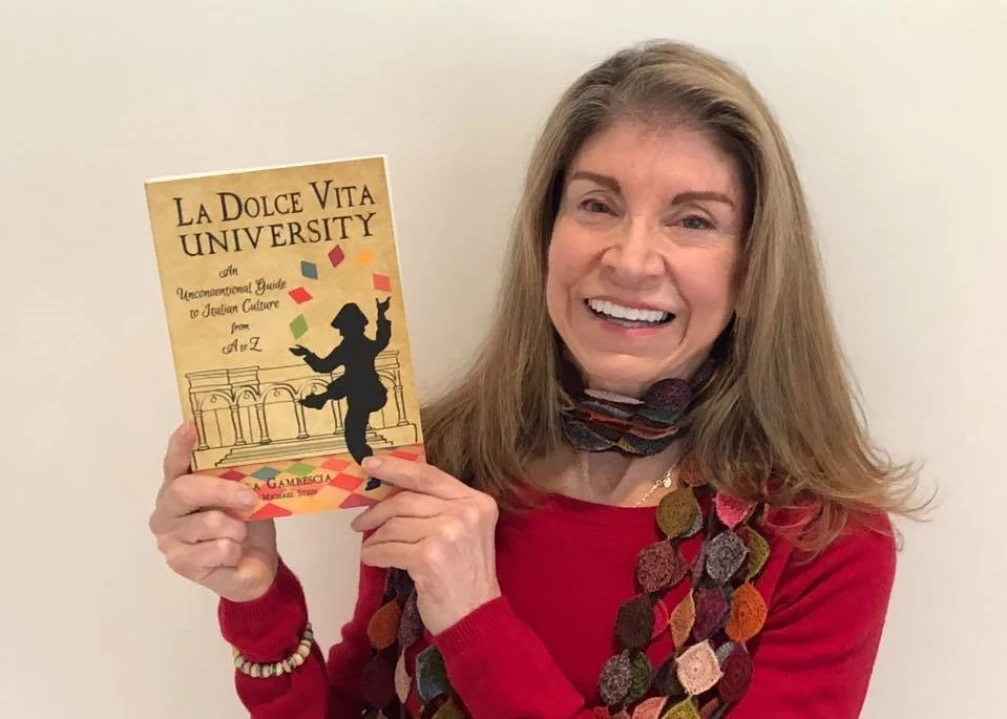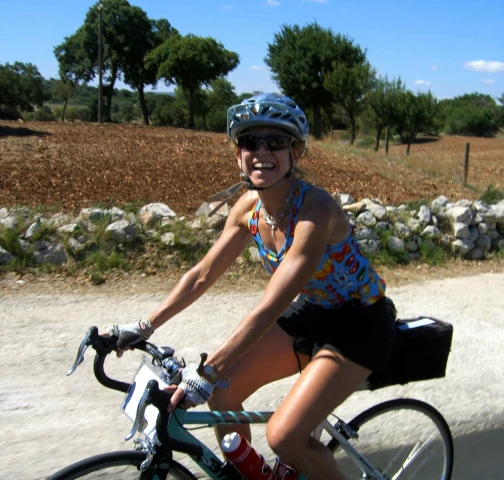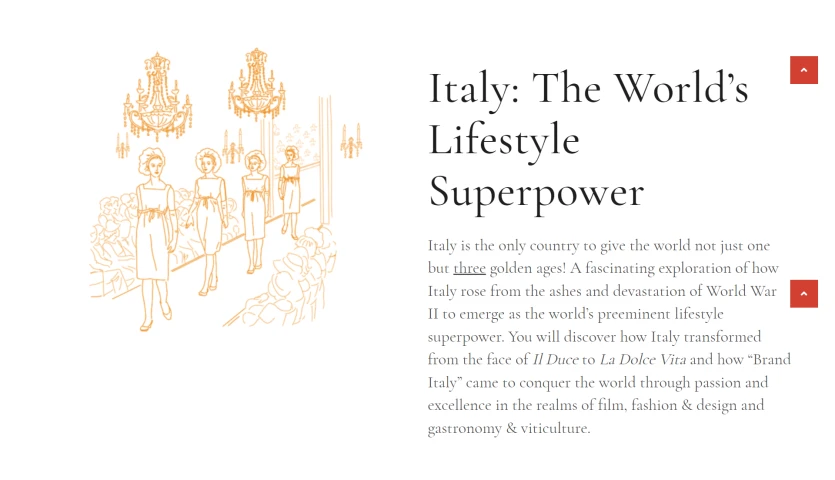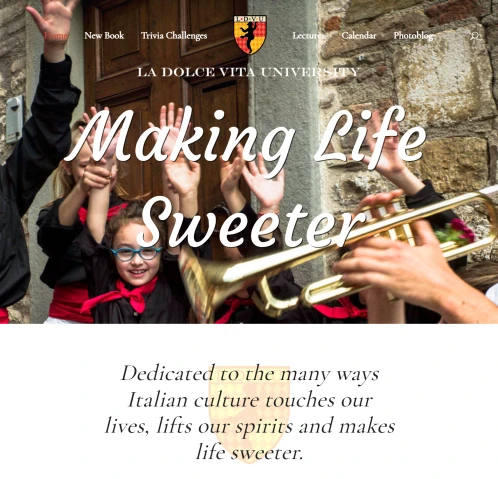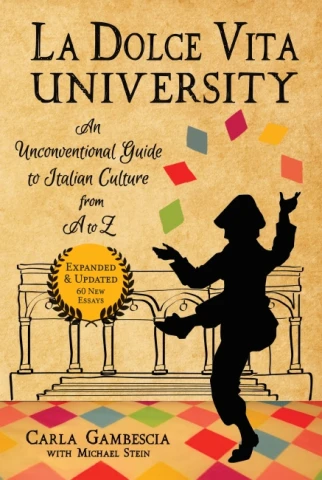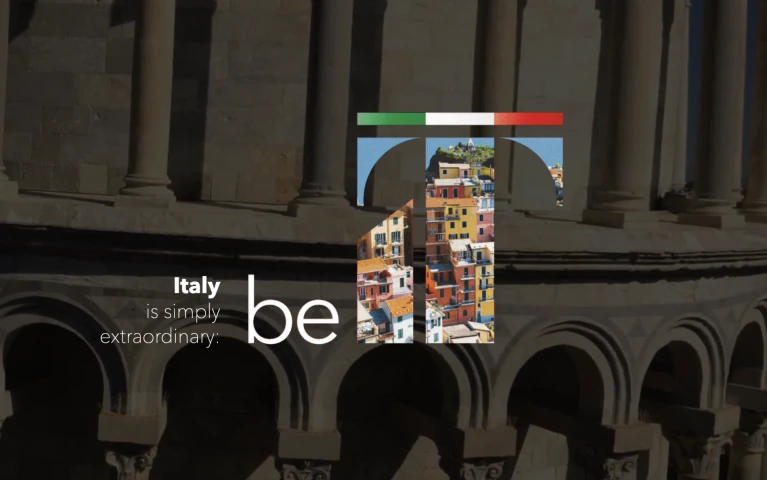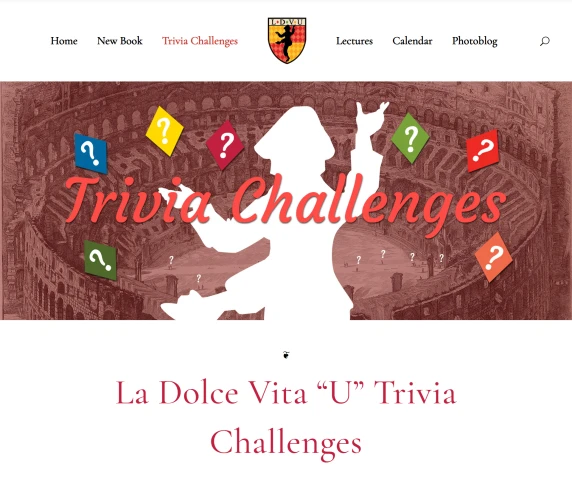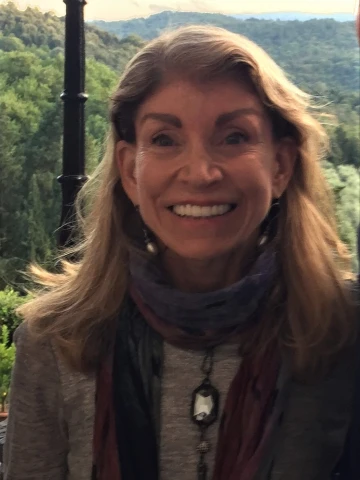We begin the eleventh year of We the Italians interviews with a true excellence in the divulgation of Italian culture in the United States. Carla Gambescia's name is known to many Americans who have the good fortune to have Italian origins and others who do not, and it is synonymous with Dolce Vita: it is precisely to Dolce Vita that Carla turns when she talks about Italian culture.
For me, Carla is a friend and a source of inspiration, so I am very happy to start 2022 by hosting her here on We the Italians, and I hope there will be opportunities to collaborate with her in the future
Carla, first of all, please tell our readers something about your Italian Heritage
As a little girl my earliest sense of myself was that I was Italian, and that somehow that made me special. I grew up in the Italian American enclave of South Philadelphia where my father was both a beloved pediatrician and a professor at the Hahnemann University School of Medicine. Although Italian was rarely spoken in our household, my parents were deeply proud of their Italian ancestry. Their pride was most strongly centered around our shared Italian cultural legacy rather than allegiance to regional identity and traditions.
Growing up I had a vague awareness that my ancestors were from the south of Italy. My father often told me we were descended from the Romans and the Medici! I certainly did not fully comprehend his meaning, but the essence of what he said affected me profoundly. It not only instilled a sense of pride in my heritage but helped shape aspirations I carry with me even today.
Only later in life did I learn that my father’s parents immigrated at the turn of the 20th century from Abruzzo and Molise and that my mother’s grandparents immigrated a generation earlier—in the 1880s—from the remote mountain town of Accettura in Basilicata’s Piccole Dolomiti. In my travels I’ve cycled through the rustic countryside of Abruzzo and Molise and have explored Basilicata both on foot and by bicycle. I hope to someday attend Il Maggio di Accettura, also known as the Wedding of the Trees, a dazzling springtime festival that blends Christian and pagan traditions.
Today I treasure a piece of furniture handed down from my maternal great-grandmother: a marble-topped pedestal commemorating the quadricentennial of Columbus’s discovery of America and manufactured at the time of the Chicago World’s Fair, also called the Columbian Exposition. The pedestal is dated June 1893. Beyond its sentimental value this piece serves as a reminder that Americans once considered Columbus a hero, a figure not unlike Teddy Roosevelt who was celebrated for his courage and spirit of discovery.
Can you tell us about the Italian American Associations and Clubs you have spoken to and visited over the years?
In the three years since my book’s original publication I’ve spoken to culturally-curious adults throughout the United States in a wide variety of general audience venues such as libraries, universities, museums, continuing education centers, restaurants, Eataly locations and private clubs. In terms of the Italian American community specifically, I have spoken to over 30 groups in 15 different states. Within that community I’ve observed some noteworthy, and I believe instructive, differences.
In the northeast, which saw this country’s greatest volume of Italian immigration, these organizations tend to be centered around Italian American identity and heritage, the immigrant experience and keeping alive the memory of parents’ and grandparents’ (and now great- and great-great-grandparents’) challenges and sacrifices. They reinforce ethnic identity and share a sense of nostalgia.
Although there are lively “Little Italy” neighborhoods in numerous cities across the U.S., as you move outside the northeast corridor Italian American organizations seem to be focused more on an affinity for Italian culture and less on Italian American identity. As a result, many of these organizations welcome as members non Italian Americans who are enthusiastic Italophiles, offering programs and activities for a broader audience that celebrate Italy’s capacious cultural heritage.
The pandemic and Zoom greatly broadened my ability to reach and connect with organizations outside the U.S. as well. For instance, I’ve enjoyed several opportunities to speak to the British-Italian Society in London, a vital group comprised of zealous Italophiles drawn together by their deep appreciation of Italy’s cultural legacy.
Returning to Italian American organizations, I believe that the model for their future success (if not also their survival) is the one based on affinity—in essence, a love of what’s Italian—rather than one based on identity—that is, where one’s ancestors happened to come from. These are two fundamentally different approaches and ways of thinking: the first is future oriented and inclusive; the second is more backward looking and exclusionary. The “identity” approach probably made a lot of sense two or more generations ago when Italian Americans faced serious discrimination and felt the need to band together for strength and mutual support. But today Italian Americans are not only part of the fabric of American society but we’re also very well represented in a broad array of leadership roles. While we Italian Americans should certainly honor our forebears in this country and support one another’s current endeavors, I also passionately believe it’s time to embrace and reciprocate the feelings of all those who love Italian culture, regardless of their inherited ethnicity. Italians have always been warm and welcoming to those who’ve approached them with respect and appreciation.
Let’s talk about lifestyle: why is Italy the World’s Lifestyle Superpower, according to your presentation?
This isn’t just hyperbole on my part—there are metrics to back it up! In recent years the weekly magazine U.S. News & World Report has conducted an annual “Best Countries” survey among approximately 20,000 adults around the globe. Each year Italy is ranked #1 in “Cultural Influence” but it’s also the top country in such specific measures as “Has great food” and “Fashionable” and “Trendy.” These are clearly significant lifestyle markers and, as it happens, they’re only part of the whole picture. In separate surveys by Conde Nast and others, Italy is also the perennial favorite travel destination of Americans and doubtless many other nationalities. Travelers love not only Italy’s cultural and natural attractions but also Italians’ expressiveness and welcoming spirit.
This speaks to the world’s embrace of Italy as a “state of mind” and the shared perception that Italians, more than any other people, really know how to live: how to dress, how to eat, how to get around, and just how to “be” in the world. People the world over aspire to a lifestyle they see as filled with beauty and one that fully engages the senses.
“Italy: The World’s Lifestyle Superpower” is one of my favorite lectures for at least two reasons. First, because it began with the realization that Italy is the only culture to have ever given the world not just one but three Golden Ages. The first two Golden Ages are of course familiar—ancient Rome and the Renaissance—but this current third Golden Age is one of lifestyle. Whereas the power of classical Rome was based on superior military force combined with superb organization (in building infrastructure and establishing governance), the glory of post-WWII Italy has been based on the power of attraction and persuasion: modern Italy has won the world’s heart.
This brings me to my second reason for loving this presentation . . . because it’s a wonderful comeback story! Just think of it: in the space of a mere two decades Italy rose phoenix-like from the ashes of World War II to transform itself from the face of Il Duce to the land of La Dolce Vita with its breathtaking ascendance in the realms of film, fashion, design, cuisine and viticulture.
I have come to believe that Italians share a special strand of “cultural DNA” that enables them to pivot and change as circumstances require. It’s a remarkable resilience I’ve noticed time and again in researching my book and lectures. That, too, is part of why I believe the world so loves Italy.
The irony is that this collective perception is not the self-perception (or even the experience) of many Italians today—but it nonetheless represents how the world sees Italy, and the admiration and esteem in which it is held.
I understand that during the pandemic you wrote a second, more expanded edition of your book … please tell us more.
The pandemic turned out to be a productive period for me. It was time for a second edition of my book (La Dolce Vita University: An Unconventional Guide to Italian Culture from A to Z) which typically would have involved only minor updates. Instead, my publisher agreed to an expanded edition with substantially more content and additional illustrations. Given the book’s unique format—an engaging compendium of Italian culture featuring dozens of mini-essays which explore fascinating and surprising aspects of Italy’s history, art, cuisine, traditions, style, legendary personalities, and more—it was easy to integrate new content to fill in what I considered some critical gaps. In fact, I added more than sixty mini-essays for a total of 125 more pages.
Titles of new essays include: Armani vs. Versace; Alpha Artists; Cinema City; A Day at the Colosseum; Fast Food in Pompeii; The Great Giorgini; Hollywood on the Tiber; Kissing the Joy; Love, Lust and Lavazza; Miracle in Matera; Naples: Beauty or Beast?; Negroni Fever; Nuns and Concubines; Opera’s Michelangelo, Spaghetti Westerns; Turnstile to Heaven; Unicorns, Dragons and Snails; The Virgil Birth; Why the Tower Leans; You’ve Come a Long Way Santa; and many more.
I also added an Afterward where I discuss my hypothesis about “Italian cultural DNA” to help explain how tiny Italy, with less than one-tenth of one percent of the planet’s landmass, could have such a monumental impact on world culture over the millennia.
On your website we can appreciate many topics you address in your lectures. Can you please tell about them to our readers?
I consider myself to be an “edu-tainer” and my greatest satisfaction comes from enlivening people’s understanding and appreciation of all that’s Italian and Italy’s multi-faceted cultural heritage. Part of keeping Italy’s rich legacy alive relies, I believe, on presenting it in engaging ways that are relevant to how we live today— exploring Italian genius over the millennia in 21st-century terms. To this end I have created a wide repertoire of programs in two principal formats: La Dolce Vita University lectures and interactive La Dolce Vita University trivia challenges.
In a La Dolce Vita “U” trivia challenge, participants get to “test” their knowledge and, in the process, discover surprising, little-known facts about Italian culture. Trivia challenges are fun and engaging, similar to a TV game show like Jeopardy, while being packed with interesting information … so you almost don’t notice how much you are learning. With a stockpile of dozens of intriguing questions, I have hosted trivia challenges for large or intimate gatherings, live and virtual audiences, university and high school students, fine dining and retail establishments, and private functions and fundraisers.
La Dolce Vita University lectures are designed to be cultural journeys brought to life with powerful visual elements. My goal is to provide fresh perspectives and new insights that enable my audiences to reach a deeper understanding and appreciation of some specific aspect, time or place relating to Italian culture. Quite a number of attendees have told me that they find these lectures uplifting and even inspiring.
Both my trivia challenges and lectures combine “brain candy” with “eye candy” and are invitations to fall in love—or to fall more deeply in love—with Italy.
You are an expert on how Italy promotes itself in the United States. What can our country do to improve in this as well?
While I’m not sure I’d consider myself an “expert” in this area I do have a genuine passion and sense of mission about Italian culture. I also happen to bring two particular perspectives to bear: one based on my experience as a career marketing professional and the other based on my unusually (and perhaps uniquely) broad exposure to diverse organizations both within and outside the Italian American community.
As a marketer, I find the Italian Trade Agency’s new “Italy is simply extraordinary: be IT” campaign to be, itself, extraordinary. It’s a beautifully produced, persuasive and uplifting celebration of Italian creativity, passion, style, heritage, innovation and diversity, all of which speak to Italy as a global brand and state of mind without equal. These are the very attributes that account not just for Italy’s past glories but also for its continuing relevance and emotional appeal to people everywhere.
But here in the United States I believe there needs to be a “reset” in how Italy and its culture are perceived, most especially—and beginning—within the Italian American community. A lot of damage has been done by the Columbus controversy, a controversy triggered by bad scholarship and fueled by an anti-Western cultural bias that has become fashionable in certain academic circles. So I completely understand the desire to address this disservice and correct the record. But if Italian American organizations focus all or even most of their advocacy efforts in defending Columbus they will risk coming off as being, well, defensive. In my opinion, at least equal attention and resources should go towards imparting a positive message: one that celebrates the many monumental and enduring gifts of Italian culture to our very way of life and the countless ways it touches us and enriches us. In other words, the bigger picture rather than a single historic figure, albeit an important one. That’s certainly what I’m trying to accomplish, in my own modest way, with my book and La Dolce Vita University programs.
Over these past four years, more than half of my lecture and trivia challenge attendees have been non Italian Americans. The irony is that they tend to be more ardent fans of Italian culture than many Italian Americans. That’s why I believe the “reset” must happen within our own community first, since many seem to have lost sight of the bigger picture of Italy’s unparalleled cultural legacy and ongoing excellence. (And I’m afraid that Italian American youth isn’t learning about this at all—certainly not in many of our schools.) Sometimes it takes an outsider’s perspective to rekindle an appreciation of one’s own cultural heritage. But once a reset can happen, Italian Americans will be able to support, preserve and extend that heritage on the basis of confidence rather than defensiveness—and, most importantly, from a place of positivity. That’s how Italians have rebounded from setbacks and prevailed as a culture throughout history.
Have you resumed lecturing in attendance, or is it still too early? What are your future plans?
I will continue to conduct programs virtually but also look forward to once again engage with live audiences. Zoom has allowed me to connect with geographically dispersed audiences that I would not be able to otherwise reach, especially during the pandemic. Since my presentations have great visual content, they work especially well on Zoom. At the same time, I love the more direct engagement that comes with live events. For instance, it’s so rewarding when I know for certain that audiences are tracking with me in real time or find a joke funny. So my plan is to phase back into more live events as the pandemic recedes.
As far as new initiatives go, I have another book project that I’m working on: a collaboration with an exceptionally talented artist and photographer (also a dear friend) currently living in Italy.
I also have a strong desire to collaborate with Italian language educators to bring La Dolce Vita University to high school and college Italian language students in order to provide an accessible window on the culture that can connect them more deeply to their language studies ... as well as to open the door to a deeper exploration of Italian culture. This is how we keep the culture alive and vital.
Finally, I’m deeply committed to serving as an agent for the kind of “reset” within the Italian American community just described and to continue my efforts as an ambassador to the broader community, sharing all the ways Italy just makes life sweeter. All of us, regardless of our inherited ethnicity, have an “inner Italian”—the most spontaneous, joyous and expressive part of us that revels in the wonders of this world. My ultimate goal is to help bring out the “inner Italian” of everyone I can reach.
Iniziamo l’undicesimo anno delle interviste di We the Italians con una vera e propria eccellenza della divulgazione della cultura italiana negli Stati Uniti. Il nome di Carla Gambescia è noto a moltissimi americani che hanno la fortuna di avere origini italiane ed altri che non ce l’hanno, ed è sinonimo di Dolce Vita: è proprio alla Dolce Vita che si rivolge Carla quando racconta la cultura italiana.
Per me Carla è un’amica ed una fonte d’ispirazione, per cui sono molto felice di iniziare il 2022 ospitandola qui su We the Italians, e spero che in futuro ci saranno occasioni di collaborare con lei
Carla, prima di tutto, racconta ai nostri lettori qualcosa della tua eredità italiana
Da bambina la mia prima percezione di me stessa era che ero italiana, e che in qualche modo questo mi rendeva speciale. Sono cresciuta nell'enclave italoamericana di South Philadelphia, dove mio padre era sia uno stimato pediatra che un professore alla Hahnemann University School of Medicine. Anche se in casa nostra si parlava raramente l'italiano, i miei genitori erano profondamente orgogliosi delle loro origini italiane. Il loro orgoglio era fortemente incentrato sulla nostra comune eredità culturale italiana, più che sulla fedeltà all'identità e alle tradizioni regionali.
Crescendo ho sviluppato una vaga consapevolezza che i miei antenati erano del sud Italia. Mio padre mi diceva spesso che discendevamo dai Romani e dai Medici! Certamente non comprendevo appieno il suo significato, ma l'essenza di ciò che diceva mi colpì profondamente. Non solo ha instillato un senso di orgoglio nella mia italianità, ma ha contribuito a formare desideri che porto con me ancora oggi.
Solo più tardi nella vita ho saputo che i genitori di mio padre sono immigrati all'inizio del ventesimo secolo dall'Abruzzo e dal Molise e che i nonni di mia madre sono immigrati una generazione prima - nel 1880 - dal remoto paese di montagna di Accettura nelle Piccole Dolomiti della Basilicata. Nei miei viaggi ho pedalato attraverso la campagna rustica dell'Abruzzo e del Molise e ho esplorato la Basilicata sia a piedi che in bicicletta. Spero un giorno di partecipare al Maggio di Accettura, conosciuto anche come lo Sposalizio degli Alberi, una meravigliosa festa di primavera che fonde tradizioni cristiane e pagane.
Oggi conservo gelosamente un mobile tramandato dalla mia bisnonna materna: un piedistallo con il piano di marmo che commemora il quadricentenario della scoperta dell'America da parte di Colombo e fabbricato all'epoca della Fiera Mondiale di Chicago, chiamata anche Esposizione Colombiana. Il piedistallo è datato giugno 1893. Al di là del suo valore sentimentale, questo pezzo serve a ricordare che un tempo gli americani consideravano Colombo un eroe, una figura non dissimile da Teddy Roosevelt, celebrato per il suo coraggio e per il suo spirito di avventura.
Puoi parlarci delle associazioni e dei club italoamericani a cui ha parlato e che hai visitato nel corso degli anni?
Nei tre anni trascorsi dalla pubblicazione del mio libro ho parlato a persone culturalmente curiose in tutti gli Stati Uniti in una grande varietà di luoghi pubblici come biblioteche, università, musei, centri di formazione, ristoranti, sedi di Eataly e club privati. Per quanto riguarda la comunità italoamericana in particolare, ho parlato a più di 30 gruppi in 15 stati diversi. All'interno di questa comunità ho osservato alcune differenze degne di nota, e credo istruttive.
Nel nord-est, che ha visto il maggior volume di immigrazione italiana di questo Paese, queste organizzazioni tendono ad essere incentrate sull'identità e l'eredità italoamericana, sull'esperienza degli immigrati e sul mantenere viva la memoria delle sfide e dei sacrifici dei genitori e dei nonni (e ora dei bisnonni e dei trisavoli). Rafforzano l'identità etnica e condividono un senso di nostalgia.
Sebbene ci siano vivaci "Little Italy" in numerose città degli Stati Uniti, man mano che ci si sposta al di fuori del corridoio nord-orientale le organizzazioni italoamericane sembrano concentrarsi maggiormente su un'affinità per la cultura italiana e meno sull'identità italoamericana. Di conseguenza, molte di queste organizzazioni accolgono come membri anche non italoamericani che sono entusiasti italofili, offrendo programmi e attività per un pubblico più ampio che celebrano l’enorme patrimonio culturale italiano.
La pandemia e zoom hanno notevolmente ampliato la mia capacità di raggiungere e connettermi con organizzazioni anche al di fuori degli Stati Uniti. Per esempio, ho avuto diverse opportunità di parlare alla British-Italian Society di Londra, un gruppo vitale composto da attenti italofili uniti dal loro profondo apprezzamento della cultura italiana.
Tornando alle organizzazioni italoamericane, credo che il modello per il loro futuro successo (se non anche per la loro sopravvivenza) sia quello basato sull'affinità - in sostanza, un amore per ciò che è italiano - piuttosto che uno basato sull'identità - cioè, da dove sono venuti i propri antenati. Si tratta di due approcci e modi di pensare fondamentalmente diversi: il primo è orientato al futuro e inclusivo; il secondo è più arretrato ed identitario. L'approccio identitario probabilmente aveva molto senso due o più generazioni fa, quando gli italoamericani affrontavano gravi discriminazioni e sentivano il bisogno di unirsi per avere forza e sostegno reciproco. Oggi gli italoamericani non solo fanno parte del tessuto della società americana, ma sono anche ben rappresentati in una vasta gamma di ruoli di leadership. Mentre noi italoamericani dovremmo certamente onorare i nostri antenati in questo Paese e sostenere reciprocamente i nostri sforzi attuali, credo anche con passione che sia il momento di abbracciare e ricambiare i sentimenti di tutti coloro che amano la cultura italiana, indipendentemente dalla loro etnia. Gli italiani sono sempre stati calorosi e accoglienti con coloro che si sono avvicinati a loro con rispetto e apprezzamento.
Parliamo di stile di vita: perché l'Italia è la superpotenza mondiale dello stile di vita, secondo la sua presentazione?
Non è solo un'iperbole da parte mia: ci sono dei dati che lo confermano! Negli ultimi anni il settimanale U.S. News & World Report ha condotto un sondaggio annuale chiamato "Best Countries" tra circa 20.000 persone adulte in tutto il mondo. Ogni anno l'Italia è al primo posto in "Influenza culturale", ma è anche il primo paese in misure specifiche come "Ha un ottimo cibo", "Alla moda" e "Trendy". Questi sono chiaramente indicatori significativi dello stile di vita e, guarda caso, sono solo una parte dell'intero quadro. In indagini separate di Conde Nast e altri, l'Italia è anche la destinazione di viaggio preferita perennemente dagli americani e senza dubbio da molte altre nazionalità. I viaggiatori amano non solo le attrazioni culturali e naturali dell'Italia, ma anche l'espressività e lo spirito di accoglienza degli italiani.
Questo parla dell'abbraccio mondiale dell'Italia come "stato d'animo" e della percezione condivisa che gli italiani, più di ogni altro popolo, sanno davvero come vivere: come vestirsi, come mangiare, come muoversi, e semplicemente come "essere" nel mondo. Le persone di tutto il mondo aspirano a uno stile di vita che considerano pieno di bellezza e che coinvolge pienamente i sensi.
"Italia: The World's Lifestyle Superpower" è una delle mie conferenze preferite per almeno due motivi. Primo, perché è iniziata con la constatazione che l'Italia è l'unica cultura ad aver dato al mondo non solo una ma tre Età dell'Oro. Le prime due età dell'oro sono ovviamente familiari - l'antica Roma e il Rinascimento - ma questa terza età dell'oro è uno stile di vita. Mentre il potere della Roma classica era basato su una forza militare superiore combinata con una superba organizzazione (nella costruzione di infrastrutture e nell'istituzione di un governo), la gloria dell'Italia del secondo dopoguerra si è basata sul potere di attrazione e persuasione: l'Italia moderna ha conquistato il cuore del mondo.
Questo mi porta alla mia seconda ragione per amare questa presentazione... perché è una meravigliosa storia di ritorno! Pensateci: nel giro di due decenni l'Italia è risorta come una fenice dalle ceneri della Seconda Guerra Mondiale per trasformarsi dal volto del Duce alla terra della Dolce Vita con la sua ascesa mozzafiato nel campo del cinema, della moda, del design, della cucina e della viticoltura.
Sono arrivata a credere che gli italiani condividano un filamento speciale di "DNA culturale" che permette loro di fare perno e cambiare a seconda delle circostanze. È una notevole capacità di recupero che ho notato più volte nella ricerca del mio libro e nelle conferenze. Anche questo è parte del perché credo che il mondo ami così tanto l'Italia.
L'ironia è che questa percezione collettiva non è l'auto-percezione (o anche l'esperienza) di molti italiani oggi - ma rappresenta comunque come il mondo vede l'Italia, e l'ammirazione e la stima in cui è tenuta.
So che durante la pandemia hai scritto una seconda edizione, più estesa, del tuo libro... dicci di più
La pandemia si è rivelata un periodo produttivo per me. Era il momento per una seconda edizione del mio libro (La Dolce Vita University: An Unconventional Guide to Italian Culture from A to Z) che tipicamente avrebbe comportato solo piccoli aggiornamenti. Invece, il mio editore ha accettato un'edizione ampliata con un contenuto sostanzialmente maggiore e illustrazioni aggiuntive. Dato il formato unico del libro - un avvincente compendio della cultura italiana con decine di mini-saggi che esplorano aspetti affascinanti e sorprendenti della storia, dell'arte, della cucina, delle tradizioni, dello stile, di personaggi leggendari e altro - è stato facile integrare nuovi contenuti per colmare quelle che consideravo alcune lacune critiche. Infatti, ho aggiunto più di sessanta mini-saggi per un totale di 125 pagine in più.
I titoli dei nuovi saggi includono: Armani contro Versace; Alpha Artists; Cinema City; Un giorno al Colosseo; Fast Food a Pompei; Il grande Giorgini; Hollywood sul Tevere; Baciare la gioia; Amore, lussuria e Lavazza; Miracolo a Matera; Napoli: Bellezza o Bestia?; Febbre da Negroni; Monache e Concubine; Michelangelo dell'Opera, Spaghetti Western; Tornello in Paradiso; Unicorni, Draghi e Lumache; La nascita di Virgilio; Perché la Torre si inclina; Hai fatto molta strada Babbo Natale; e molti altri.
Ho anche aggiunto una postfazione in cui discuto la mia ipotesi sul "DNA culturale italiano" per aiutare a spiegare come la piccola Italia, con meno di un decimo dell'1% della superficie del pianeta, possa avere avuto un impatto così monumentale sulla cultura mondiale nel corso dei millenni.
Sul tuo sito web possiamo apprezzare molti argomenti che affronti nelle tue conferenze. Può parlarne ai nostri lettori?
Mi considero una "educatrice" e la mia più grande soddisfazione proviene dal ravvivare la comprensione e l'apprezzamento delle persone per tutto ciò che è italiano e per lo sfaccettato patrimonio culturale italiano. Parte del mantenere viva la ricca eredità dell'Italia si basa, credo, sul presentarla in modi coinvolgenti che siano rilevanti per come viviamo oggi - esplorando il genio italiano nel corso dei millenni in termini del ventunesimo secolo. A questo scopo ho creato un ampio repertorio di programmi in due formati principali: Le conferenze de La Dolce Vita University e le sfide interattive de La Dolce Vita University.
In una sfida di La Dolce Vita "U" trivia, i partecipanti possono "testare" le loro conoscenze e, nel processo, scoprire fatti sorprendenti e poco conosciuti sulla cultura italiana. Le sfide a quiz sono divertenti e coinvolgenti, simili a un gioco televisivo come Jeopardy, e allo stesso tempo sono ricche di informazioni interessanti... tanto che quasi non ci si accorge di quanto si sta imparando. Con una scorta di dozzine di domande intriganti, ho ospitato sfide di Trivia per grandi o intime riunioni, pubblico dal vivo e virtuale, studenti universitari e delle scuole superiori, ristoranti raffinati e negozi, funzioni private e raccolte di fondi.
Le conferenze de La Dolce Vita University sono progettate per essere viaggi culturali portati in vita con potenti elementi visivi. Il mio obiettivo è quello di fornire nuove prospettive e nuove intuizioni che permettano al mio pubblico di raggiungere una più profonda comprensione e apprezzamento di qualche specifico aspetto, tempo o luogo relativo alla cultura italiana. Un buon numero di partecipanti mi ha detto che trova queste conferenze edificanti e persino ispiranti.
Sia le mie sfide a quiz che le mie conferenze combinano "chicche per il cervello" con " chicche per gli occhi" e sono inviti a innamorarsi - o a innamorarsi più profondamente - dell'Italia.
Sei un’esperta di come l'Italia si promuove negli Stati Uniti. Cosa può fare il nostro paese per migliorare anche in questo?
Anche se non sono sicuro di considerarmi un’esperta in questo campo, ho una passione genuina e un senso di missione per la promozione della cultura italiana. Mi capita anche di portare due prospettive particolari: una basata sulla mia esperienza come professionista del marketing e l'altra basata sulla mia insolitamente (e forse unicamente) ampia esposizione a diverse organizzazioni sia all'interno che all'esterno della comunità italoamericana.
Come marketer, trovo che la nuova campagna dell'Italian Trade Agency "L'Italia è semplicemente straordinaria: beIT" sia, essa stessa, straordinaria. È una celebrazione ben prodotta, persuasiva ed edificante della creatività italiana, della passione, dello stile, del patrimonio, dell'innovazione e della diversità, che parlano dell'Italia come di un marchio globale e di uno stato d'animo senza pari. Questi sono gli stessi attributi che spiegano non solo le glorie passate dell'Italia, ma anche la sua continua rilevanza e il suo fascino emotivo per le persone di tutto il mondo.
Ma qui negli Stati Uniti credo che ci sia bisogno di un "reset" nel modo in cui l'Italia e la sua cultura sono percepite, soprattutto - e cominciando - all'interno della comunità italoamericana. Molti danni sono stati fatti dalla controversia su Colombo, una controversia innescata da una cattiva educazione e alimentata da un pregiudizio culturale anti-occidentale che è diventato di moda in certi circoli accademici. Quindi capisco perfettamente il desiderio di affrontare questo problema e correggere il tiro. Ma se le organizzazioni italoamericane concentrano tutti o anche la maggior parte dei loro sforzi di advocacy nella difesa di Colombo, rischiano di apparire come se stessero sulla difensiva. A mio parere, almeno la stessa attenzione e le stesse risorse dovrebbero essere destinate a trasmettere un messaggio positivo: uno che celebri i molti doni monumentali e duraturi della cultura italiana al nostro stesso stile di vita e gli innumerevoli modi in cui ci tocca e ci arricchisce. In altre parole, il quadro generale piuttosto che una singola figura storica, anche se importante. Questo è certamente ciò che sto cercando di realizzare, nel mio modesto modo, con il mio libro e i programmi della Dolce Vita University.
In questi ultimi quattro anni, più della metà dei partecipanti alle mie conferenze e alle sfide a quiz sono stati non italoamericani. L'ironia è che essi tendono ad essere più convinti fan della cultura italiana di molti italoamericani. Ecco perché credo che il "reset" debba avvenire prima all'interno della nostra comunità, dato che molti sembrano aver perso di vista il quadro generale dell'impareggiabile eredità culturale dell'Italia e della sua continua eccellenza (E temo che la gioventù italoamericana non stia imparando nulla di tutto questo, certamente non in molte delle nostre scuole). A volte ci vuole la prospettiva di un estraneo per riaccendere l'apprezzamento della propria eredità culturale. Ma una volta avvenuto un reset, gli italoamericani saranno in grado di sostenere, preservare ed estendere quel patrimonio sulla base della fiducia piuttosto che dell’approccio difensivista - e, soprattutto, da una base di partenza di positività. È così che gli italiani si sono ripresi dalle battute d'arresto e hanno prevalso come cultura nel corso della storia.
Hai ripreso a dare lezioni in presenza o è ancora troppo presto? Quali sono i tuoi progetti futuri?
Continuerò a condurre programmi virtualmente, ma non vedo l'ora di impegnarmi ancora una volta con il pubblico dal vivo. Zoom mi ha permesso di connettermi con un pubblico geograficamente disperso che non sarei stato in grado di raggiungere altrimenti, specialmente durante la pandemia. Poiché le mie presentazioni hanno un grande contenuto visivo, funzionano particolarmente bene su zoom. Allo stesso tempo, amo l'impegno più diretto che viene dagli eventi dal vivo. Per esempio, è così gratificante quando so per certo che il pubblico sta seguendo con me in tempo reale o trova una battuta divertente. Quindi il mio piano è di ritornare gradualmente a più eventi dal vivo quando la pandemia si ritirerà.
Per quanto riguarda le nuove iniziative, ho un altro progetto di libro a cui sto lavorando: una collaborazione con un artista e fotografo di eccezionale talento (anche un caro amico) che attualmente vive in Italia.
Ho anche un forte desiderio di collaborare con gli educatori di lingua italiana per portare La Dolce Vita University agli studenti di lingua italiana delle scuole superiori e del college, al fine di fornire una finestra accessibile sulla cultura che possa collegarli più profondamente ai loro studi di lingua ... così come per aprire la porta ad una più profonda esplorazione della cultura italiana. Questo è il modo in cui manteniamo la cultura viva e vitale.
Infine, sono profondamente impegnata per il tipo di "reset" all'interno della comunità italoamericana appena descritto e a continuare i miei sforzi come ambasciatore nella comunità più ampia, condividendo tutti i modi in cui l'Italia rende la vita più dolce. Tutti noi, indipendentemente dalla nostra etnia, abbiamo un "italiano interiore" - la parte più spontanea, gioiosa ed espressiva di noi che si diverte con le meraviglie di questo mondo. Il mio obiettivo finale è quello di aiutare a far emergere l'"italiano interiore" di tutti quelli che riesco a raggiungere.


